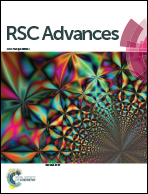Facile ZnO-based nanomaterial and its fabrication as a supercapacitor electrode: synthesis, characterization and electrochemical studies
Abstract
In recent times, tremendous efforts have been devoted to the efficient and cost-effective advancements of electrochemically active metal oxide nanomaterials. Here, we have synthesized a facile nanomaterial of ZnO@PdO/Pd by employing extracted fuel from E. cognata leaves following a hydrothermal route. The phyto-fueled ZnO@PdO/Pd nanomaterial was fabricated into a supercapacitor electrode and was scrutinized by galvanostatic charge–discharge, electrochemical impedance spectroscopy and cyclic voltammetry to evaluate its energy storage potential, and transport of electrons and conductivity. Substantial specific capacitance i.e., 178 F g−1 was obtained in the current study in aKOH electrolyte solution. A specific energy density of 3.7 W h Kg−1 was measured using the charge–discharge data. A high power density of 3718 W Kg−1 was observed for the ZnO@PdO/Pd electrode. Furthermore, the observed low internal resistance of 0.4 Ω suggested effective electron- and ion diffusion. Thus, the superb electrochemical behavior of the ZnO@PdO/Pd nanocomposite was exposed, as verified by the significant redox behavior shown by cyclic voltammetry and galvanostatic charge–discharge.



 Please wait while we load your content...
Please wait while we load your content...